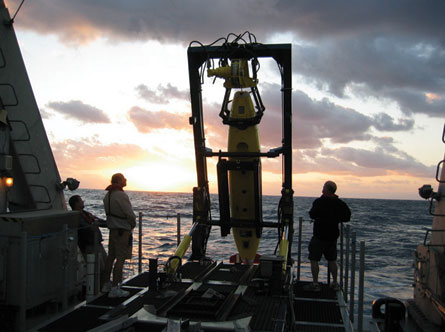Finding objects on the sea floor is the technological equivalent of the proverbial needle in the haystack. Hard to navigate and image, Hydroid overcame the typical dilemmas of the deep, turning up two big discoveries so far this year.
A subsidiary of Kongsberg Maritime, Hydroid used its Remus 6000 autonomous underwater vehicle (AUV) for the first major unearthing, locating the remnants of Air France Flight 447, which crashed off the coast of Brazil in 2009.
Although the cause of the crash remains a mystery, the AUV found the Airbus A330-200's black box, which revealed that the pilots kept trying to pull up the plane during a stall in the midst of a thunderstorm.
Led by Woods Hole Oceanographic Institution researchers, the team used two Remus 6000s from the Waitt Institute for Discovery and a third vehicle from the Leibniz Institute of Marine Sciences. Capable of diving to 3.7 miles with a dive endurance of 20 h, the Remuses were equipped with EdgeTech dual-frequency side scan sonar and 4-megapixel digital cameras.
The Remus 6000s discovered large pieces of debris one week into the search, initially unearthing the plane's wings, engine, landing gear and fuselage. They went onto find the bodies of passengers and eventually the black box. This mission was the fourth attempt to find the aircraft since its crash and marked the second attempt to discover the site by Woods Hole.
 |
|---|
Hydroid's Remus in Atlantic search |
The crash site was located about 2.5 miles below the surface on 3 April. After one Remus uncovered debris on the floor, the Woods Hole team deployed a second to the location to confirm the finding with more detailed sonar mapping and imaging.
"We were confident from phase three [the last search attempt] that if we were searching in the right area, the vehicles' sonar could pick out the aircraft," says David Gallo, the project leader at Woods Hole.
Gallo previously described the area of the crash as extremely rugged, and he anticipated the search would be difficult, despite Woods Hole's 30 years of experience exploring Brazil's Mid-Ocean Ridge.
At the other end of Hydroid's spectrum of autonomous vehicles is the Remus 100 AUV and its May discovery of a World War I German U-boat that's been missing since October 1917.
Rated to 328ft deep, the Remus 100 was deployed by the Royal Netherlands Navy to locate the submarine off the coast of Terschelling in the Netherlands.
A remotely operated vehicle designed to find mines initially spotted an outline of the U-boat, one of 329 German subs used during World War I. That led to the formal mission with the Remus 100.
"These findings always happen by chance," said expedition head Capt. Lt. Jouke Spoelstra. "Twelve years ago, a hydrographic survey ship passed the same spot of our discovery, but the German vessel must have still been under a layer of sand. We were lucky to be at the right place at the right time."
Diving to 131ft, the Remus 100 found a brass plate engraved with the serial number of the German U-106 submarine. The sub was notable for sinking the HMS Contest and damaging the British-flag City of Lincoln steamer in the First Battle of the Atlantic in 1917. The U-boat met its own end after striking a mine less than a month after the battle.
Source: Flight Daily News




















